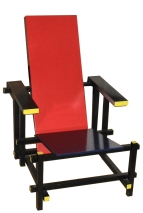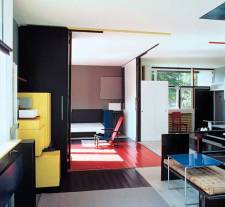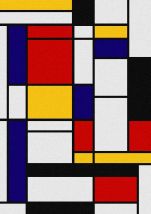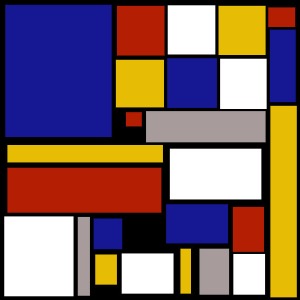Amongst the chaos of the war and the revolutionary new perception of painting, in the Netherlands there was a huge interest in ‘new art’. Because the Netherlands remained neutral during the war, dutch artists weren’t able to leave the country after 1914 and kept them isolated from the world of international art, most importantly, Pairs, which was the art centre at the time. During this time, artist Theo Van Doesburg started gathering artists to set up a journal and create a new and unique art movement. Doesburg was also a writer, poet and critic who at the time was more successful writing about art than actually creating it. In 1915 artist Theo Van Doseburg started meeting and collecting artists who eventually became some of the founding members of the Journal. Piet Mondrian was the first artist he met, as an exhibition in Amsterdam. Mondrian had moved to pairs during 1912 but wasn’t allowed to leave once war broke out. Doesbury later met Vilmos Huszar, poet Anthony Kok and architect Gerrid Rietveld and formed the movement.
The De Stijl style mainly consists of the 3 primary colours, and the 3 primary values, mised with horizontal and vertical lines. This style was used in paintings, architecture and furniture. The most famous example of De Stijl architecture is the Schroder House, designed by Rieitveld in Utrecht, the Netherlands in 1924.
These are some examples of furniture and the inside decor of a house inspired by the De Stijl style. They follow the same design technique as the paintings of just using the primary colours, the primary values and the horizontal and vertical lines.
Like other movement of the time, De Stijl, which simply translates to ‘the style’ in dutch, emerged in response to the horrors of the world war, and tired to remake society. De Stijl embraced a utopian vision of art and transformative potential and was used to distract people from the horrors and deviation the world war brought.
Some of the most important artists of the movement were, Theo Van Doseburg, Piet Mondrian, Jan Wils, Gerrit Rietveld, and Jean Gorin.
(Rietveld, Chair (unknown date))
(Piet Mondrian, 1939-42)
(Rietveld Schroder, House Interior 1924)
This is my take on a piece of art from the movement. To make this I went on photoshop and placed blue, yellow, red, grey and white boxes onto a black background. It was important to create a layout that didn’t look to crowded, too random, or have any of the boxes overlapping. Im really pleased with how this came out and think that it looks like a piece of art from the movement and I feel I was successful in creating something in the same style but made it modern by making it on a modern software such as photoshop.



